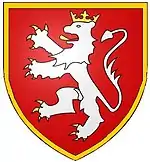Amaury de Clisson | |
|---|---|
| Breton Knight and Emissary to England | |
 Coat of Arms Clisson Cadet Family | |
| Full name | Amaury de Clisson |
| Born | around 1304 Château de Clisson, Brittany |
| Died | 2 August 1347 Battle of La Roche-Derrien |
| Nationality | Breton |
| Noble family | de Clisson |
| Spouse(s) | Isabeau de Ramefort |
| Issue | Amaury II de Clisson, Isabeau de Clisson, Mahaut de Clisson |
| Father | Olivier III de Clisson |
| Mother | Isabelle de Craon |
Amaury de Clisson (1304–1347), was a Breton knight who became the chief emissary for Jeanne de Penthièvre to the court of Edward III of England.
He was the brother of Garnier de Clisson, defender of Brest against John of Montfort and another brother, Olivier IV de Clisson who became embroiled in the intrigue of the Siege of Vannes and was subsequently executed by the King of France for perceived treason.[1]
Marriage
Amaury married Isabeau de Ramefort, Dame of Ramefort and Mortiercrolles, probably celebrated in Angers in 1333. Together their lands included Blandinais, Avrille and Ramfort.They had three children:
- Amaury II, who died with no issue;[2]
- Isabeau, who after the death of her brother, married in 1354 to Renaud d'Ancenis. By 8 March 1383, Isabeau had lost her husband; and
- Mahaut, who married Guy de Bauçay.
During the Breton War of Succession
During the Breton War of Succession, Amaury de Clisson with his brothers initially all sided with the French choice for the empty Breton ducal crown, Charles de Blois against the English choice, John de Montfort. Amaury was assigned to protect Jugon but was captured by the Montfortists. It is apparently at this time that he switched sides. As a result of his new prominence in the Montfortist camp, his lands in French controlled Brittany were confiscated in October 1344 and given to William the Binder.
Regent of Brittany
Afture the capture of John de Montfort, Amaury was appointed regent of Brittany and tutor to the young Duke.
Emissary to England
De Clisson concluded an agreement on behalf of the Montfortists on 10 March 1342, in Westminster with Edward III of England and returned to Brittany with 6,000 archers saving the de Montforts who at this stage were besieged at the port city of Hennebont.[3][4][5]
Defender of Hennebont
De Clisson remained the main Breton commander at Hennebont against the Franco-Breton siege of the city. Chroniclers, state that two captured Breton knights were to be killed by Luis de la Cerda at the base of the city's rampart. The Anglo-Breton defenders apparently had spies in the Franco-Breton camp and became aware of the situation, resolving to try everything to snatch them back. While de Clisson simulated a distraction to attract the attention of the besiegers, the English co-commander Walter de Mauny diverted around the walls and recaptured the two knights returning with them.[6]
Battle of La Roche-Derrien
De Clisson was involved and apparently killed in the Battle of La Roche-Derrien which was fought on 20 June 1347 during the night between Anglo-Breton and Franco-Breton forces. Approximately 4,000–5,000 French, Breton and Genoese mercenaries laid siege to the town of La Roche-Derrien in the hope of luring the Anglo-Bretons into an open pitched battle.[7]
See also
- Jean de Beaumanoir, opposing co-commander in the army of Charles de Blois.
- Jeanne de Clisson, his sister in law
- Joan, Duchess of Brittany, also known as Jeanne de Penthièvre.
- John IV, Duke of Brittany, husband of Jeanne de Penthièvre.
- Olivier IV de Clisson, his brother
- Philip VI of France
References
- ↑ Bougraud, F. Some notes on the Lords of Clisson (1180-1320), in Bulletin de la societe archaeogique et historique de Nantes et de Loire-Atlantique, 2000, pgs 112-115
- ↑ "Le Chateau de Ramefort de Gennes et ses seigneurs aux XIVe et XVe siècles d'après des documents inédits" (PDF). bibnum.enc.sorbonne.fr. Archived (PDF) from the original on 2015-06-05. Retrieved 14 January 2022.
- ↑ Peyronnet, G., "The sources of the medieval history of Brittany in England", Annales de Bretagne, vol. 96, p. 306,
On March 10, 1342, the letters patent of Edward 3, King of England, announced that, by agreement between him and Amaury de Clisson, tutor of John, son of John, Duke of Brittany and Count of Montfort and Richmond, all the villae, burgi, castra, fortalitia and portus maris of the Duchy of Brittany were to be handed over to Edward 3 during the duration of the war in Brittany.
The King and Amaury de Clisson also agreed to entrust the custody of all these places to a Walter de Mauny - ↑ Longman, W (1869). The History of the Life and Times of Edward the Third. Vol. 1. Germany: Salzwasser Verlag GmbH. ISBN 978-3-75250-023-3.
- ↑ Sismondi (vol.x. pg 200) states that de Clisson frustratingly waited to be received by Edward III as he was otherwise engaged, de Clisson came to England in or before March 1342, during that month Edward wrote several orders specifically referring to an agreement with de Clisson, which prove the time of his visit.
- ↑ Annales de la Faculte des Lettres de Bordeaux, XXXV Annee, Bulletin Hispanique, Fonde en 1898-1899 par G, Cirot, E. Merimee, Tome 15 -1913, Swets & Zeitlinger N.V. - Amsterdam, 1970
- ↑ "Death, Treachery, & A Victory Against the Odds: Sir Thomas Dagworth & The Battle of La Roche Derrien". The Postgrad Chronicles. Archived from the original on 2018-12-13. Retrieved 14 January 2022.